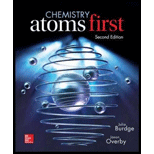
Concept explainers
Interpretation:
The blank table should be filled.
Concept introduction:
Anion: negatively charged atom or a molecule is called anion and it has more number of electrons.
Cation: positively charged atom or a molecule is called cation and it has less number of electrons.
Naming the ions and ionic compound:
A monoatomic cation is named by adding the word ion to the name of the element. Therefore, the ion of potassium
Some of the metal such as manganese (Mn) will form cations with three or more different charges. Therefore Roman numeral is used for the giving name for the inorganic compound. Roman numeral I indicates one positive charge, II means two positive charge, and so on.
For example,
A monoatomic anion is ending with –ide along with ion, therefore, the anion of chlorine (
Want to see the full answer?
Check out a sample textbook solution
Chapter 5 Solutions
Chemistry: Atoms First
- Two samples of different compounds of nitrogen and oxygen have the following compositions. Show that the compounds follow the law of multiple proportions. What is the ratio of oxygen in the two compounds for a fixed amount of nitrogen? Amount N Amount O Compound A 1.206 g 2.755 g Compound B 1.651 g 4.714 garrow_forwardTwo samples of different compounds of sulfur and oxygen have the following compositions. Show that the compounds follow the law of multiple proportions. What is the ratio of oxygen in the two compounds for a fixed amount of sulfur? Amount S Amount O Compound A l.210g 1.811 g Compound B 1.783 g 1.779 garrow_forwardGive three examples of gaseous elements that exist as diatomic molecules. Give three examples of gaseous elements that exist as monatomic species.arrow_forward
- Assume silicon has three major isotopes in nature as shown in the table below. Fill in the missing information. Isotope Mass (u) Abundance 28Si 27.98 _____ 29Si ____ 4.70% 30Si 29.97 3.09%arrow_forwardFill in the following table:arrow_forwardThe following isotopes have applications in medicine. Write their symbols in the form XZA. a. cobalt-60 b. phosphorus-32 c. iodine-131 d. sulfur-35arrow_forward
- 2.92 A candy manufacturer makes chocolate-covered cherries. Although all of the products look roughly the same, 3% of them are missing the cherry. The mass of the candy with a cherry is 18.5 g; those missing the cherry weigh only 6.4 g. (a) How would you compute the average mass of a box of 100 of these chocolate covered cherries from this manufacturer? (b) I low is this question analogous to the determination of atomic weights?arrow_forwardAmmonia gas reacts with molecular oxygen gas to form nitrogen monoxide gas and liquid water. Write the complete balanced reaction with all proper state symbols.arrow_forwardWrite the chemical formula of each of the following: a The compound made up of a crystal with two particles coming from chromium atoms for every three particles coming from oxygen atoms. b The compound made up of a crystal with one particle coming from a barium atom for every two particles coming from chlorine atoms. c The compound made up of molecules with 12 carbon atoms, 22 hydrogen atoms, and 11 oxygen atoms. d The compound made up of molecules with three hydrogen atoms, one phosphorus atom, and four oxygen atoms.arrow_forward
- 2.94 Use a molecular level description to distinguish between LDPE and HDPE.arrow_forwardWrite the chemical formula of each of the following: a The compound made up of a crystal with one particle coming from a nickel atom for every two particles coming from chlorine atoms. b The compound made up of a crystal with two particles coming from silver atoms for every one particle coming from an oxygen atom. c The compound made up of molecules with six carbon atoms, 12 hydrogen atoms, and six oxygen atoms. d The compound made up of molecules with two hydrogen atoms, one sulfur atom, and four oxygen atoms.arrow_forward
 General, Organic, and Biological ChemistryChemistryISBN:9781285853918Author:H. Stephen StokerPublisher:Cengage Learning
General, Organic, and Biological ChemistryChemistryISBN:9781285853918Author:H. Stephen StokerPublisher:Cengage Learning ChemistryChemistryISBN:9781305957404Author:Steven S. Zumdahl, Susan A. Zumdahl, Donald J. DeCostePublisher:Cengage Learning
ChemistryChemistryISBN:9781305957404Author:Steven S. Zumdahl, Susan A. Zumdahl, Donald J. DeCostePublisher:Cengage Learning
 Chemistry: An Atoms First ApproachChemistryISBN:9781305079243Author:Steven S. Zumdahl, Susan A. ZumdahlPublisher:Cengage Learning
Chemistry: An Atoms First ApproachChemistryISBN:9781305079243Author:Steven S. Zumdahl, Susan A. ZumdahlPublisher:Cengage Learning Chemistry: Principles and PracticeChemistryISBN:9780534420123Author:Daniel L. Reger, Scott R. Goode, David W. Ball, Edward MercerPublisher:Cengage Learning
Chemistry: Principles and PracticeChemistryISBN:9780534420123Author:Daniel L. Reger, Scott R. Goode, David W. Ball, Edward MercerPublisher:Cengage Learning Introductory Chemistry: A FoundationChemistryISBN:9781337399425Author:Steven S. Zumdahl, Donald J. DeCostePublisher:Cengage Learning
Introductory Chemistry: A FoundationChemistryISBN:9781337399425Author:Steven S. Zumdahl, Donald J. DeCostePublisher:Cengage Learning





